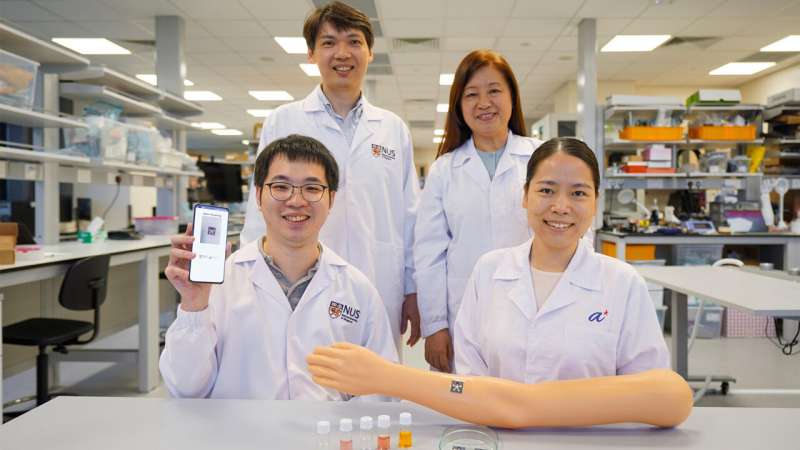This article has been reviewed according to Science X's editorial process and policies. Editors have highlighted the following attributes while ensuring the content's credibility:
fact-checked
peer-reviewed publication
trusted source
proofread
Battery-free sensor analyzes five wound biomarkers in a single patch

Most wearable wound sensors measure only one or a small number of parameters, and they require bulky printed circuit boards and batteries. The PETAL sensor patch, on the other hand, currently measures five biomarkers and does not require any battery to operate. More biomarkers can be added if required.
Each PETAL sensor patch consists of a fluidic panel patterned in the form of a five-petal pinwheel flower, with each "petal" acting as a sensing region. An opening in the center of the fluidic panel collects fluid from wound and distributes the fluid evenly via five sampling channels to the sensing regions for analysis. Each sensing region uses a different color-changing chemical to detect and measure the respective wound indicators—namely temperature, pH, trimethylamine, uric acid and moisture.
The fluidic panel is sandwiched between two thin films. The top transparent silicone layer allows for normal skin functions of oxygen and moisture exchange, and it also enables image display for accurate image capture and analysis. The bottom wound contact layer gently attaches the sensor patch to the skin and protects the wound bed from direct contact with the sensor panel, to minimize wound tissue disruptions.
After sufficient wound fluid is accumulated (usually within a few hours or over a few days), the PETAL sensor patch will complete the detection of biomarkers within 15 minutes. Images or a video of the sensor patch can be recorded on a mobile phone for classification using the proprietary AI algorithm.
In lab experiments, the PETAL sensor patch demonstrated a high accuracy of 97% in differentiating healing and non-healing chronic and burn wounds.
Timely and effective monitoring of wound healing status is critical to wound care and management. Impaired wound healing, such as chronic wounds (i.e. those that do not heal after three months) and post-burn pathological scars, could result in life-threatening medical complications and considerable economic burden to patients and healthcare systems worldwide.
A recent invention by a team of researchers from the National University of Singapore (NUS) and A*STAR's Institute of Materials Research and Engineering (IMRE), provides a simple, convenient and effective way of monitoring wound recovery so that clinical intervention can be triggered in a timely manner to improve wound care and management.
Currently, wound healing is typically examined visually by a clinician. Wound infections are mostly diagnosed via swabbing followed by a bacteria culture which involves long waiting time and does not provide timely wound diagnosis. This makes accurate prediction of wound healing challenging in the clinical setting. In addition, wound assessment typically requires frequent manual removal of dressing, which elevates the risks of infection and may cause additional pain and trauma for patients.
"To address this challenge, NUS researchers combined our expertise in flexible electronics, artificial intelligence (AI) and sensor data processing with nanosensor capabilities of IMRE researchers to develop an innovative solution that could benefit patients with complex wound conditions," said Associate Professor Benjamin Tee from the Department of Materials Science and Engineering under the NUS College of Design and Engineering, and the NUS Institute for Health Innovation & Technology.
The PETAL (paper-like, battery-free, in situ, AI-enabled multiplexed) sensor patch comprises of five colorimetric sensors that can determine the patient's wound healing status within 15 minutes by measuring a combination of biomarkers—temperature, pH, trimethylamine, uric acid and moisture of the wound. These biomarkers were carefully selected to effectively assess wound inflammation, infection as well as the condition of the wound environment.
"We designed the paper-like PETAL sensor patch to be thin, flexible and biocompatible, allowing it to be easily and safely integrated with wound dressing for the detection of biomarkers. We can thus potentially use this convenient sensor patch for prompt, low-cost wound care management at hospitals or even in non-specialist healthcare settings such as homes," explained Dr. Su Xiaodi, Principal Scientist, Soft Materials Department, A*STAR's IMRE.
The sensor patch is able to operate without an energy source—sensor images are captured by a mobile phone and analyzed by AI algorithms to determine the patient's healing status.
Assoc Prof Tee said, "Our AI algorithm is capable of rapidly processing data from a digital image of the sensor patch for very accurate classification of healing status. This can be done without removing the sensor from the wound. In this way, doctors and patients can monitor wounds more regularly with little interruption to wound healing. Timely medical intervention can then be administered appropriately to prevent adverse complications and scarring."
The design and fabrication of the PETAL sensor patch was reported in the journal Science Advances on 16 June 2023.
There are no apparent signs of adverse reactions observed on the skin surface in contact with the PETAL sensor patch over four days, demonstrating the biocompatibility of the PETAL sensor patch for ambulatory wound monitoring.
In the current study, the performance of the PETAL sensor patch was demonstrated on chronic wounds and burn wounds. This AI-enabled technology can be adapted and customized for other wound types, by incorporating different colorimetric sensors, such as glucose, lactate or Interleukin-6 for diabetic ulcers. The number of detection zones can also be easily reconfigured to detect different biomarkers concurrently, so its application can be broadened for different wound types.
An international patent for this invention has been filed and the researchers plan to advance to human clinical trials next.
More information: Xin Ting Zheng et al, Battery-free and AI-enabled multiplexed sensor patches for wound monitoring, Science Advances (2023). DOI: 10.1126/sciadv.adg6670




















